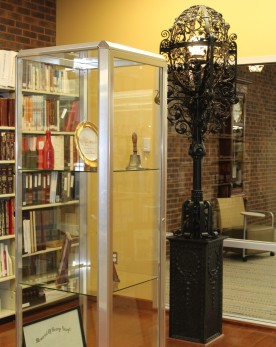By Jared Olar
Library assistant
Tuesday, Nov. 22, 2016, was the 53rd anniversary of the assassination of President John Fitzgerald Kennedy. The marking of that somber memorial this week provides an opportunity for us to consider a somewhat unusual item that recently was donated to the Pekin Public Library’s Local History Room collection.
The item in question is a copy of a World War II-era group photograph that was donated to the library by Peter Moreschi of Pekin. The photo, showing eight men who presumably were all U.S. Army soldiers, was taken during the war, and seems to have been taken somewhere in the U.S. or possibly in Europe. Moreschi’s father-in-law Conrad C. Zank (1921-2001) is shown in the back row, second from the left. According to his obituary published in the Pekin Daily Times, Zank served in the Army from 5 Dec. 1942 until 26 Oct. 1945, serving in Iceland and Europe. Moreschi says Zank enlisted or was drafted on 23 Nov. 1942 in Peoria. These dates help to narrow down when the photo was taken.
What makes the photograph unusual is the man squatting in the front row and center, who bears a remarkable resemblance to a younger John F. Kennedy (or perhaps an even closer resemblance to his brother Robert Kennedy). Moreschi says he has consulted with the John F. Kennedy Presidential Library & Museum, whose staff couldn’t say that Kennedy, who served in the Navy in World War II, would have been at the same time and place as Zank and other Army soldiers during the war years.

This World War II-era photograph shows Conrad C. Zank (1921-2001) of Pekin, in the back row, second from the left. Squatting in the front row is perhaps — or perhaps not — a future U.S. president. PHOTO PROVIDED BY PETER MORESCHI
It would have been most unusual, albeit not impossible, for a Navy sailor to be in a photograph with Army soldiers. It is well known that Kennedy served in the U.S. Naval Reserve during World War II. He entered the Naval Reserve in Sept. 1941 and was commissioned as an Ensign on Oct. 26, 1941. He was first assigned to the Office of Naval Intelligence in Washington, D.C., but in Jan. 1942 he was sent to the ONI field office in Charleston, S.C. From July 27 to Sept. 27, 1942, Kennedy was in Chicago for training at the Naval Reserve Officer Training School at Northwestern University.
After that, he volunteered to enter the Motor Torpedo Boat Squadrons Training Center in Melville, R.I. During his training, Kennedy was promoted to lieutenant junior grade on Oct. 10, completing his training on Dec. 2, 1942. This was about the time that Zank entered the U.S. Army in Peoria.
Upon his completion of his torpedo boat training, Kennedy was assigned to Motor Torpedo Squadron Four and became a PT boat instructor in Melville. He had command of the training vessel PT-101 from Dec. 7, 1942, to Feb. 23, 1943. Around that time, Kennedy led PT-101, PT-98, and PT-99 from Melville, R.I., to Jacksonville, Fla. After that, he was assigned to Panama and then sent to the Pacific Theater of the war. On April 24, 1943, Kennedy became the commander of PT-109. On the night of Aug. 1-2, PT-109 was rammed by the Japanese destroyer Amagiri, which cut the boat in half, killing two crewmen instantly. Kennedy’s heroism during this incident, in which he helped to save his surviving crewmen, even towing one of them to safety by clenching the injured man’s life jacket strap in his teeth, earned him the Navy and Marine Corps Medal and a Purple Heart.
Kennedy continued as a PT boat commander in the Pacific Theater until Nov. 18, 1943, when he was sent back to the U.S., arriving in early Jan. 1944. He was in Chelsea Naval Hospital, Chelsea, Mass., from May to Dec. 1944, being released from active duty in late 1944. From January to March 1945, Kennedy was in Castle Hot Springs, Ariz. He was honorably discharged from the Naval Reserve on March 1, 1945, and a month later he started a job a special correspondent for Hearst Newspapers in April that year. This was about seven months before Zank completed his World War II service in the U.S. Army.
Could there have been any stretches of time when Zank and Kennedy were in the same place? Perhaps, even though it would be unlikely for someone in the Naval Reserve to pose in a photo with a group of Army soldiers. However, next to nothing is known of where Zank was during his years of service. It’s most likely that the man in Moreschi’s photo isn’t JFK, but a JFK doppelganger.
Anyone who can help identify “JFK” and the other men in the photo may contact the Pekin Public Library at (309) 347-7111.
